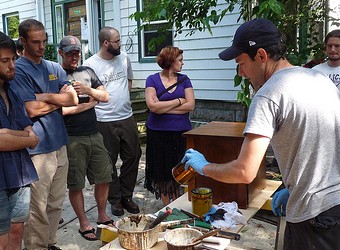During the Progressive Era that ended with World War I, there was a popular economic imperative to make land common property, especially with regard to urbanized land. This meant not that land should be nationalized or occupied communally. Instead the concept was similar to the one applied when an estate is left in common to its inheritors, which often leads to them renting out the property and splitting the proceeds equally among themselves.
In the Progressive Era view, humanity inherited the earth “in common” so its land should – for both moral and economic reasons — be “rented out” to those holding title to it, with society collecting the rent in the form of a tax equal to the land tract’s annual rental value. This fund would then be used to pay for the public goods and services that contribute to land’s value, with surplus funds divided equally as a per capita dividend to the public.
Failing to publicly collect the land value as a form of common wealth by leaving it in private hands has profound environmental and economic consequences. Environmentally, it means that landholders can occupy much more land than they can effectively use, either neglecting it or holding it for speculation, (i.e. waiting for its value to go up before cashing in). Today this means a checkerboard pattern of development with vacant or derelict lots dotting urbanized regions while construction is pushed outward in a sprawl pattern that is environmentally unsustainable.
Currently, the only way one can profit from land is to develop it or sell it. However, if the profit from land were viewed as our common wealth, then we’d benefit to the degree that the land in our region was best used – which includes non-use. To illustrate, consider Central Park in Manhattan. Every time developers go to the city council with proposals to develop within the park, New York rejects the proposals. Not because the Green Party has taken over the Big Apple but because of the bottom line. The city gets more revenue from the surrounding properties with the park kept open than it would if the park were developed from border to border. Open space is profitable to the community, even if not to any individual owner of the open space. Hence, to remove the motive to develop every parcel of land – and to be fair to all owners – it’s necessary to combine the value of all land in a region into a common fund, then share the revenue as an equitable dividend to residents.
Economically, it is land value that drives both the business cycle and long term economic trends. Regarding the business cycle, the “housing bubble bursts” that regularly (on average, every 18 years) crash our economies, as in 2008, are actually land-value bubbles. When people talk about housing’s “property value” or “market value” in terms of how that value fluctuates, they are largely referring to housing’s location, not its building value. Buildings age and wear out; it’s locations that constantly grow in value as a region’s population grows.
Because the price of land – and therefore how much money must be borrowed to buy it – is affected by how much bidders have to pay in taxes for it, whatever value that is not taxed usually gets pledged to banks as a mortgage. In recent years, these mortgages have been in turn packaged into securities that are sold on Wall Street, with all-too familiar results. If instead homeowners in effect rented their home sites from the community and only the costs of buildings were financed, we would remove the economic volatility created when land values and mortgage-financing feed off each other.
Regarding long term trends, as emphasized by Nobel Laureate economist Joseph Stiglitz, our society’s increasing inequality damages our economy because it diminishes the middle class purchasing power that keeps our economy humming. But one of the prime causes of increasing inequality is the increasing concentration of ownership and control of land and other natural resources — down to six big lenders after the crash and bailout, and about the same number of oil companies and media conglomerates — all made possible by letting powerful insiders capture the worth of Earth rather than having society share natural values among all its members.
In the Progressive Era, this view was illustrated in the precursor to the board game Monopoly. As typically played, Monopoly ends with a single player eventually owning everything—a reflection of the current economic system. Under rules of the earlier The Landlord’s Game, all land rent was paid into the kitty with the result that gains were spread to all the players instead of concentrating in the hands of a single winner. In Monopoly, the collection of $200 when passing “Go” seems to be a vestige of the land rent dividend paid to players. The older, cooperative rules might not make for such a fun board game, but if the principles were applied to the real economy it would mean a more fun life for the 99%.
Collecting what belongs to everyone becomes an automatic way to harmonize our economy with our environment. Once we recognize our common wealth, we can recover that immense flow and defend our common space. Doing so would usher in a new progressive era unlike any before.








